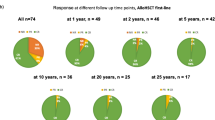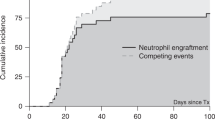Abstract
We studied the incidence of relapse, transformation to myelodysplastic syndrome/acute myeloid leukemia, and survival in patients with aplastic anemia (AA) surviving more than 1 year after ATG/ALG-based immunosuppressive therapy (IST) between 1985 and 2020. Four-hundred seventy patients (413 adults and 57 children) were studied, and data were compared with 223 patients who underwent matched sibling donor transplant (MSD HSCT). Median follow-up is 50 months (12–359). Relapse occurred in 21.9% at a median time of 33.5 months (5–228) post IST. Twenty-six (5.5%) patients progressed to PNH, while 20 (4.3%) evolved to MDS/AML. Ten-year estimated overall survival (OS) is 80.9 ± 3% and was significantly better in patients without an event (85.1 ± 4%) compared to relapse (74.6% ± 6.2%) or clonal evolution (12.8% ± 11.8%) (p = 0.024). While the severity of AA (p = 0.011) and type of ATG (p = 0.028) used predicted relapse, only age at IST administration influenced clonal evolution (p = 0.018). Among HSCT recipients, relapse rates were 4.9% with no clonal evolution, and the 10-year OS was 94.5 ± 2%. In patients who survived 1 year following IST, outcomes were good except with clonal evolution to MDS/AML. These outcomes, however, were still inferior compared to matched sibling donor HSCT.





Similar content being viewed by others
Data availability
Primary data is available with the first and corresponding author on appropriate request.
References
Young NS (2018) Aplastic anemia. N Engl J Med. 379(17):1643–56
Risitano AM, Maciejewski JP, Green S, Plasilova M, Zeng W, Young NS (2004) In-vivo dominant immune responses in aplastic anaemia: molecular tracking of putatively pathogenetic T-cell clones by TCR β-CDR3 sequencing. Lancet 364(9431):355–364
Scheinberg P (2021) Acquired severe aplastic anaemia: how medical therapy evolved in the 20th and 21st centuries. Br J Haematol 194(6):954–969
Killick SB, Bown N, Cavenagh J, Dokal I, Foukaneli T, Hill A et al (2016) Guidelines for the diagnosis and management of adult aplastic anaemia. Br J Haematol 172(2):187–207
Ogawa S (2016) Clonal hematopoiesis in acquired aplastic anemia. Blood 128(3):337–347
Drexler B, Zurbriggen F, Diesch T, Viollier R, Halter JP, Heim D et al (2020) Very long-term follow-up of aplastic anemia treated with immunosuppressive therapy or allogeneic hematopoietic cell transplantation. Ann Hematol 99(11):2529–2538
Patel BA, Groarke EM, Lotter J, Shalhoub R, Gutierrez-Rodrigues F, Rios O et al (2022) Long-term outcomes in patients with severe aplastic anemia treated with immunosuppression and eltrombopag: a phase 2 study. Blood 139(1):34–43
Paquette RL, Tebyani N, Frane M, Ireland P, Ho WG, Champlin RE et al (1995) Long-term outcome of aplastic anemia in adults treated with antithymocyte globulin: comparison with bone marrow transplantation. Blood 85(1):283–290
Rosenfeld S, Follmann D, Nunez O, Young NS (2003) Antithymocyte globulin and cyclosporine for severe aplastic anemia: association between hematologic response and long-term outcome. JAMA 289(9):1130–1135
Frickhofen N, Rosenfeld SJ (2000) Immunosuppressive treatment of aplastic anemia with antithymocyte globulin and cyclosporine. Semin Hematol 37(1):56–68
Tichelli A, Schrezenmeier H, Socié G, Marsh J, Bacigalupo A, Dührsen U et al (2011) A randomized controlled study in patients with newly diagnosed severe aplastic anemia receiving antithymocyte globulin (ATG), cyclosporine, with or without G-CSF: a study of the SAA Working Party of the European Group for Blood and Marrow Transplantation. Blood 117(17):4434–4441
Teramura M, Kimura A, Iwase S, Yonemura Y, Nakao S, Urabe A et al (2007) Treatment of severe aplastic anemia with antithymocyte globulin and cyclosporin A with or without G-CSF in adults: a multicenter randomized study in Japan. Blood 110(6):1756–1761
Sakamoto T, Obara N, Kurita N, Sakata-Yanagimoto M, Nishikii H, Yokoyama Y et al (2013) Effectiveness and safety of rabbit anti-thymocyte globulin in Japanese patients with aplastic anemia. Int J Hematol 98(3):319–322
Bacigalupo A (2017) How I treat acquired aplastic anemia. Blood 129(11):1428–1436
Townsley DM, Scheinberg P, Winkler T, Desmond R, Dumitriu B, Rios O et al (2017) Eltrombopag added to standard immunosuppression for aplastic anemia. N Engl J Med 376(16):1540–1550
Peffault de Latour R, Kulasekararaj A, Iacobelli S, Terwel SR, Cook R, Griffin M et al (2022) Eltrombopag added to immunosuppression in severe aplastic anemia. N Engl J Med 386(1):11–23
George B, Mathews V, Viswabandya A, Abraham A, Ganapule A, Fouzia NA et al (2015) Immunosuppressive therapy and bone marrow transplantation for aplastic anaemia–the CMC experience. J Assoc Physicians India. 63(3 Suppl):36–40
Frickhofen N, Heimpel H, Kaltwasser JP, Schrezenmeier H, for the German Aplastic Anemia Study Group (2003) Anti-thymocyte globulin with or without cyclosporine: 11 year follow up of a randomized trial comparing treatments of aplastic anemia. Blood 101:1236–1242
Scheinberg P, Wu CO, Nunez O, Scheinberg P, Boss C, Sloand EM et al (2009) Treatment of severe aplastic anemia with a combination of horse antithymocyte globulin and cyclosporine, with or without sirolimus: a prospective randomized study. Haematologica 94(3):348–354
Bacigalupo A, Bruno B, Saracco P, Di Bona E, Locasciulli A, Locatelli F et al (2000) Antilymphocyte globulin, cyclosporine, prednisolone, and granulocyte colony-stimulating factor for severe aplastic anemia: an update of the GITMO/EBMT study on 100 patients. European Group for Blood and Marrow Transplantation (EBMT) Working Party on Severe Aplastic Anemia and the Gruppo Italiano Trapianti di Midolio Osseo (GITMO). Blood 95(6):1931–4
Eylem E, Yahya B, Ozlen B, Umit M, Gursel G, Ayse I et al (2015) Not all anti-T lymphocyte globulin preparations are suitable for use in aplastic anemia: significantly inferior results with Jurkat cell-reactive anti-T lymphocyte globulin in clinical practice. Int J Clin Exp Med 8(9):16334–16339
Socie G, Henry-Amar M, Bacigalupo A, Hows J, Tichelli A, Ljungman P et al (1993) Malignant tumors occurring after treatment of aplastic anemia. N Engl J Med 329(16):1152–1157
Li Y, Li X, Ge M, Shi J, Qian L, Zheng Y et al (2011) Long-term follow-up of clonal evolutions in 802 aplastic anemia patients: a single-center experience. Ann Hematol 90(5):529–537
Jalaeikhoo H, Khajeh-Mehrizi A (2015) Immunosuppressive therapy in patients with aplastic anemia: a single-center retrospective study. PLoS ONE 10(5):e0126925
Hu J, Zhang L, Zhao X, Liu X, Jing L, Zhou K et al (2022) First-line immunosuppressive therapy with rATG and CsA for severe aplastic anaemia: 15 years’ experience. Ann Hematol 101(11):2405–2412
Gurnari C, Pagliuca S, Prata PH, Galimard JE, Catto LFB, Larcher L et al (2023) Clinical and molecular determinants of clonal evolution in aplastic anemia and paroxysmal nocturnal hemoglobinuria. J Clin Oncol 41(1):132–142
Yang W, Liu W, Zhao X, Zhang L, Peng G, Ye L et al (2023) Antihuman T lymphocyte porcine immunoglobulin combined with cyclosporine as first line immunosuppressive therapy for severe aplastic anemia in China: a large single-center 10-year retrospective study. Ther Adv Hematol 14:20406207221146030. https://doi.org/10.1177/20406207221146031
Kojima S, Ohara A, Tsuchida M, Kudoh T, Hanada R, Okimoto Y et al (2002) Risk factors for evolution of acquired aplastic anemia into myelodysplastic syndrome and acute myeloid leukemia after immunosuppressive therapy in children. Blood 100(3):786–790
Scheinberg P, Wu CO, Nunez O, Young NS (2008) Long term outcome of pediatric patients with severe aplastic anemia treated with anti-thymocyte globulin and cyclosporine. J Pediatr 153(6):814–819
Kamio T, Ito E, Ohara A, Kosaka Y, Tsuchida M, Yagasaki H et al (2011) Relapse of aplastic anemia in children after immunosuppressive therapy: a report from the Japan Childhood Aplastic Anemia Study Group. Haematologica 96(6):814–819
Groarke EM, Patel BA, Diamond C, Gutierrez-Rodrigues F, Vicente A, Rios O et al (2019) Outcomes in pediatric patients with severe aplastic anemia treated with standard immunosuppression and eltrombopag. Blood 134:454
Rogers ZR, Nakano TA, Olson TS, Bertuch AA, Wang W, Gillio A et al (2019) Immunosuppressive therapy for pediatric aplastic anemia: a North American Pediatric Aplastic Anemia Consortium study. Haematologica 104(10):1974–1983
Scheinberg P, Rios O, Scheinberg P, Weinstein B, Wu CO, Young NS (2014) Prolonged cyclosporine administration after antithymocyte globulin delays but does not prevent relapse in severe aplastic anemia. Am J Hematol 89(6):571–574
Luzzatto L, Bessler M, Rotoli B (1997) Somatic mutations in paroxysmal nocturnal hemoglobinuria: a blessing in disguise? Cell 88(1):1–4
de Latour RP, Risitano A, Dufour C (2019). Severe aplastic anemia and PNH. In: Carreras E, Dufour C, Mohty M, Kröger N, editors. The EBMT handbook: hematopoietic stem cell transplantation and cellular therapies [Internet]. Cham: Springer International Publishing; p. 579–85. https://doi.org/10.1007/978-3-030-02278-5_77
Rother RP, Rollins SA, Mojcik CF, Brodsky RA, Bell L (2007) Discovery and development of the complement inhibitor eculizumab for the treatment of paroxysmal nocturnal hemoglobinuria. Nat Biotechnol 25(11):1256–1264
Emadi A, Brodsky RA (2009) Successful discontinuation of anticoagulation following eculizumab administration in paroxysmal nocturnal hemoglobinuria. Am J Hematol 84(10):699–701
Parker C, Omine M, Richards S, Nishimura J, ichi, Bessler M, Ware R, et al (2005) Diagnosis and management of paroxysmal nocturnal hemoglobinuria. Blood 106(12):3699–3709
Groarke EM, Patel BA, Shalhoub R, Gutierrez-Rodrigues F, Desai P, Leuva H et al (2022) Predictors of clonal evolution and myeloid neoplasia following immunosuppressive therapy in severe aplastic anemia. Leukemia 36(9):2328–2337
Jeong DC, Chung NG, Cho B, Zou Y, Ruan M, Takahashi Y et al (2014) Long-term outcome after immunosuppressive therapy with horse or rabbit antithymocyte globulin and cyclosporine for severe aplastic anemia in children. Haematologica 99(4):664–671
Wong FL, Teh JB, Atencio L, Stiller T, Kim H, Chanson D et al (2020) Conditional survival, cause-specific mortality, and risk factors of late mortality after allogeneic hematopoietic cell transplantation. JNCI J Natl Cancer Inst 112(11):1153–1161
Author information
Authors and Affiliations
Contributions
SC and BG designed the study, performed the research, analyzed the data, and wrote the paper; KM.L performed the statistical analysis, analyzed the data, and edited the paper; SL, SS, AJ.D, AK, UK, FN.A, AS, VM, and AA recruited and treated the patients, provided critical advice, and reviewed the paper. All authors have read and approved the final manuscript.
Corresponding author
Ethics declarations
Ethical approval
All procedures followed were in accordance with the ethical standards of the responsible committee on human experimentation (institutional and national) and with the Helsinki Declaration of 1975, as revised in 2008. This study was approved by the Institutional Review Board of Christian Medical College, Vellore, India.
Consent to participate
Since it is a retrospective study, consent requirement was waived for retrospective participants by the above-named ethics committee.
Conflict of interest
The authors declare no competing interests.
Additional information
Publisher's Note
Springer Nature remains neutral with regard to jurisdictional claims in published maps and institutional affiliations.
Rights and permissions
Springer Nature or its licensor (e.g. a society or other partner) holds exclusive rights to this article under a publishing agreement with the author(s) or other rightsholder(s); author self-archiving of the accepted manuscript version of this article is solely governed by the terms of such publishing agreement and applicable law.
About this article
Cite this article
Chattopadhyay, S., Lionel, S., Selvarajan, S. et al. Relapse and transformation to myelodysplastic syndrome and acute myeloid leukemia following immunosuppressive therapy for aplastic anemia is more common as compared to allogeneic stem cell transplantation with a negative impact on survival. Ann Hematol 103, 749–758 (2024). https://doi.org/10.1007/s00277-024-05621-2
Received:
Accepted:
Published:
Issue Date:
DOI: https://doi.org/10.1007/s00277-024-05621-2




